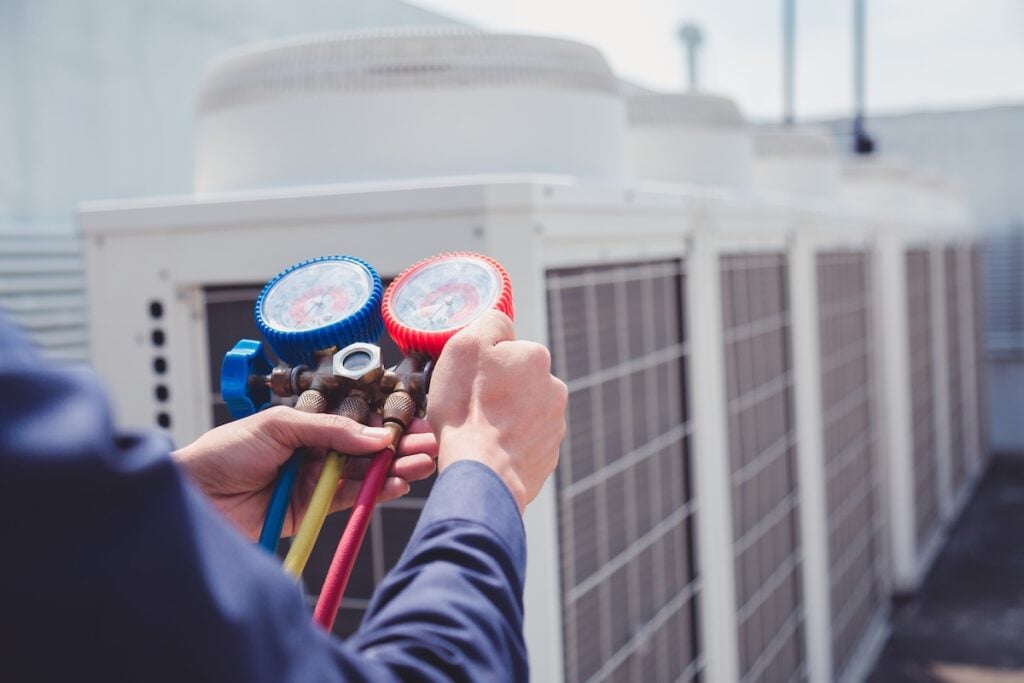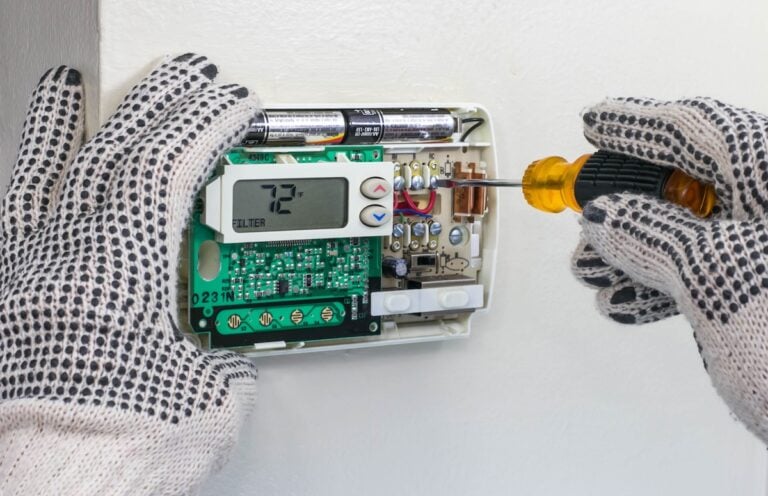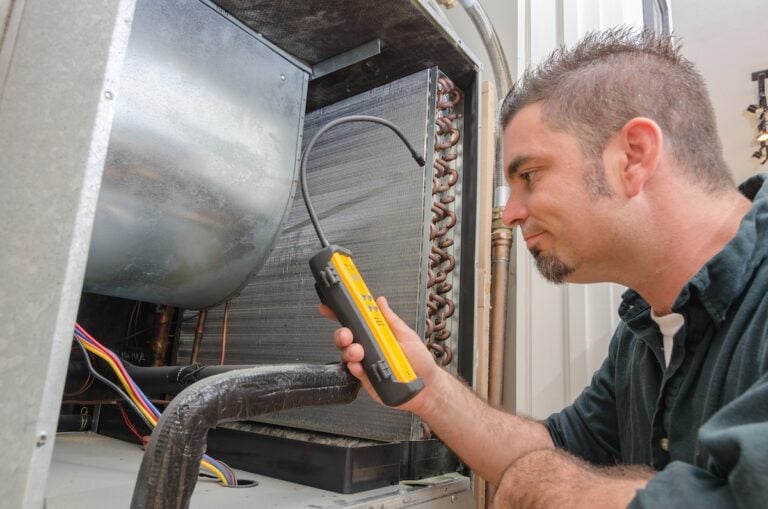
Installing a commercial HVAC system is a complex undertaking that requires careful planning, skilled technicians, and attention to detail. Whether you’re building a new facility or replacing an outdated system, understanding the commercial HVAC installation process helps you make informed decisions and ensures your project runs smoothly.
This comprehensive guide walks you through every aspect of commercial HVAC installation, from initial planning to final testing. You’ll learn about the essential steps involved, common challenges to expect, and how to work with qualified professionals to achieve optimal results. We’ll also cover key considerations like system sizing, equipment selection, and regulatory compliance to help you navigate this important investment with confidence.
Here’s what we’ll explore in this article:
- Planning and Assessment – Understanding your building’s unique requirements
- Installation Process – The detailed 8-step installation procedure
- Testing and Commissioning – Ensuring everything works perfectly
- Maintenance Planning – Setting up your system for long-term success
🔎 Planning and Assessment

Thorough planning is the cornerstone of any successful commercial HVAC installation. This process begins with evaluating your building’s specific needs, existing infrastructure, and operational requirements. A qualified HVAC contractor will assess heating and cooling loads by measuring square footage, analyzing insulation, window placement, and occupancy patterns. They will also examine electrical systems, ductwork, and structural elements to ensure compatibility with modern HVAC equipment, especially in buildings with older infrastructure. Addressing these factors early can prevent unexpected costs and ensure the system is both energy-efficient and properly sized.
Budget and timeline planning are also critical components of the process. Commercial HVAC systems are significant investments, with costs varying based on building size, system complexity, and equipment quality. Open discussions with contractors can help identify solutions that balance performance and cost-effectiveness. Additionally, clear timeline planning minimizes disruptions to business operations, especially since installations often require coordination with other trades, building occupants, and facility managers. Establishing schedules and communication protocols is essential to keeping the project on track.
System Design and Engineering
- Customized HVAC Solutions: Professional system design transforms building assessments into tailored HVAC solutions using specialized software to model airflow, calculate load requirements, and optimize equipment placement.
- Load Calculations: Engineers determine heating and cooling capacities based on factors like climate, building orientation, internal heat sources, and occupancy levels. Accurate calculations prevent oversized or undersized systems, improving efficiency and comfort.
- Ductwork Design: Proper duct system design ensures efficient air distribution, minimizing pressure losses and noise while maximizing system performance and reducing energy consumption.
- Equipment Selection: Engineers choose components like heating and cooling units, air handlers, controls, and accessories based on energy efficiency, maintenance needs, and system compatibility.
- Zone Planning: Buildings are divided into zones with similar heating and cooling requirements. This approach improves comfort and energy efficiency by allowing independent control of different areas, especially in spaces with varied occupancy or uses..
✅ 8 Step Commercial HVAC Installation Process

The actual installation of a commercial HVAC system follows a systematic approach that ensures proper operation and compliance with all requirements. Here’s the detailed process professional contractors use:
Step 1: Site Preparation and Safety Setup
Installation begins with preparing the work area and establishing safety protocols. Contractors set up protective barriers, ensure proper ventilation, and establish clear access routes for equipment delivery. All team members receive safety briefings and review project-specific hazards.
Step 2: Structural Modifications and Mounting
Any required structural modifications are completed before equipment installation. This may include reinforcing roof structures for rooftop units, creating equipment pads, or modifying walls for unit placement. Proper mounting ensures equipment stability and reduces vibration transmission.
Step 3: Electrical Infrastructure Installation
Electrical work includes installing power supplies, control wiring, and safety disconnects. Licensed electricians ensure all electrical connections meet code requirements and provide proper equipment protection. This step often requires coordination with local utility companies.
Step 4: Ductwork Installation and Sealing
Ductwork installation follows engineered designs to ensure proper airflow distribution. Contractors fabricate and install supply and return ducts, ensuring proper sealing to prevent air leaks. Quality ductwork installation directly impacts system efficiency and performance.
Step 5: Equipment Placement and Connection
HVAC equipment is carefully positioned and secured according to manufacturer specifications. This includes installing outdoor units, indoor air handlers, and associated components. Proper equipment placement ensures optimal performance and simplifies future maintenance.
Step 6: Refrigerant Lines and Gas Connections
Refrigerant lines are installed and pressure tested to ensure leak-free operation. Gas connections for heating equipment require certified technicians and pressure testing for safety. These connections must meet strict safety standards and local codes.
Step 7: Control System Integration
Building automation systems and controls are installed and programmed according to project specifications. This includes installing sensors, thermostats, and communication networks that allow centralized system management. Proper control integration optimizes energy efficiency and comfort.
Step 8: System Startup and Initial Testing
The final installation step involves starting up all equipment and conducting initial performance tests. Contractors verify proper operation, check safety systems, and ensure all components function as designed. This step identifies any issues before the commissioning phase.
🔎 Testing and Commissioning
Comprehensive testing and commissioning ensure your commercial HVAC system operates safely, efficiently, and according to design specifications. This critical phase validates that all components work together properly and meet performance expectations.
Functional Testing
Functional testing verifies that all system components operate correctly. This includes testing heating and cooling equipment, fans, pumps, and control systems under various operating conditions. Contractors document all test results and address any performance issues discovered.
Airflow Testing
Airflow testing ensures proper air distribution throughout the building. Technicians measure airflow rates at supply and return vents, verify proper ventilation levels, and check for adequate air circulation. Proper airflow is essential for comfort and indoor air quality.
Control System Testing
Control system testing validates that building automation systems respond correctly to various inputs. This includes testing temperature sensors, scheduling functions, and emergency shutdown procedures. Proper control operation ensures efficient system operation and occupant comfort.
Performance Verification
Performance verification compares actual system performance to design specifications. This includes measuring capacity, efficiency, and energy consumption under various operating conditions. Performance testing ensures your system meets contractual requirements and operates efficiently.
Documentation Completion
Documentation completion provides you with essential system information. This includes equipment manuals, warranty information, maintenance schedules, and as-built drawings. Proper documentation supports effective system operation and maintenance throughout the equipment lifecycle.
🛠️ Maintenance Planning

Establishing a comprehensive maintenance plan immediately after installation protects your investment and ensures long-term system reliability. Proper maintenance prevents costly breakdowns, extends equipment life, and maintains energy efficiency.
Establish Preventive Maintenance Schedules
Preventive maintenance schedules should be based on manufacturer recommendations and system usage patterns. Regular tasks include filter changes, coil cleaning, belt inspections, and lubricating moving parts. Consistent maintenance prevents small issues from becoming major problems.
Service Agreements with Contractors
Service agreements with qualified contractors provide ongoing support and priority service. These agreements often include regular maintenance visits, emergency repairs, and preferential scheduling. Professional maintenance ensures your system gets expert care throughout its lifecycle.
Training for Facility Staff
Training facility staff helps maintain optimal operation between professional service visits. Basic training should cover filter changes, thermostat use, and recognizing potential issues. Well-trained staff can handle minor problems and support professional maintenance efforts.
Record Keeping and System Monitoring
Record keeping tracks system performance and maintenance history. Detailed records help identify trends, process warranty claims, and guide maintenance decisions. Modern building automation systems can log performance data automatically and alert staff to potential issues.
👉 Why Choose Thelen Mechanical for Your Commercial HVAC Installation
When it comes to commercial HVAC installation, you need a team you can trust to deliver quality, efficiency, and reliability. At Thelen Mechanical, we combine years of expertise, licensed technicians, and a commitment to minimizing business disruptions to ensure your system is installed and maintained to the highest standards. From tailored planning to 24/7 emergency support, we go above and beyond to protect your investment and keep your operations running smoothly.
Ready to partner with a team dedicated to your business’s comfort and success? Contact Thelen Mechanical today to schedule your free consultation. Let us help you create the ideal environment for your business to thrive.
Unlock Our Limited-Time Deals!
Take advantage of our offers on AC tune-ups, new installs, repairs, and more.
We Can’t Wait to Help Your Home!
"*" indicates required fields





